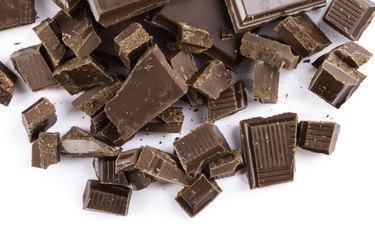
Feeling nauseous and bloated after drinking milk? Do you experience digestive distress after eating dairy? These are common signs of lactose intolerance, a condition that affects around 65 percent of all people. Don't fret, though — this doesn't mean you must give up chocolate and other goodies containing milk; you can always opt for dairy-free chocolate and extra dark chocolate, which are just as delicious.
Tip
Just because you have lactose intolerance, doesn’t mean you can’t eat chocolate. Stick to small servings and see how your body reacts. Consider switching to extra dark or dairy-free chocolate.
Video of the Day
What Is Lactose Intolerance?
Lactose intolerance is one of the most common health complaints worldwide. People struggling with this condition cannot digest lactose properly. This sugar, which consists of galactose and glucose, is present naturally in milk and its derivatives. Your body may not produce enough lactase, an enzyme that helps digest lactose.
Video of the Day
According to Johns Hopkins Medicine, this condition often has genetic causes. If your parents or siblings have lactose intolerance, you may develop this condition too. Its symptoms range from mild to severe, and vary from one person to another. These usually include:
- Nausea and vomiting
- Bloating
- Gas
- Diarrhea
- Stomach pain
- Abdominal cramps
The severity of your symptoms depends on your gut flora, the sensitivity of your gastrointestinal tract, gastrointestinal mobility and the amount of lactose ingested, according to a 2015 review published in the journal Nutrients.
Some people are born with lactose intolerance, while others develop it later in life. Certain diseases and infections can stop lactase production, limiting your ability to digest and process milk and dairy. If you have this condition, lactose goes directly into your colon instead of being absorbed.
Lactose in Milk Chocolate
Depending on your symptoms, you may or may not be able to eat milk and dairy. Some individuals can eat or drink small amounts of these foods without experiencing side effects. It all comes down to how your body reacts. Additionally, certain products that contain lactose are easier to digest than others.
The amount of lactose in milk chocolate varies from one brand to another. As its name suggests, this delicious treat is made with milk. Therefore, it contains more lactose compared to dark chocolate and dairy-free alternatives.
As the Mayo Clinic points out, lactose intolerance symptoms kick in 30 minutes to two hours after you ingest milk or dairy. If you eat chocolate and experience indigestion, consider switching to a different brand. Enzyme supplements and probiotics may help too.
Some Remedies
A 2019 pilot study published in the journal Probiotics and Antimicrobial Proteins has found that subjects with lactose intolerance who took probiotics for six months experienced major improvements in their symptoms. The severity of bloating and gas was dramatically reduced.
Another study, which was published in the journal Nutrients in 2018, suggests that prebiotics, probiotics and oral enzymes can relieve the symptoms associated with this condition. Additionally, switching to the FODMAP diet appears to have positive results. This dietary plan limits the consumption of foods high in fermentable carbs.
Read more: Lactose Intolerance & Probiotics
Manufacturers are not required to state the amount of lactose in milk chocolate on the label. Therefore, the only way to determine whether or not you can enjoy this treat is to eat a small serving and see how your body reacts. The same goes for yogurt, cake, cookies and other foods that contain milk and dairy.
Cheese lactose content, for example, depends on the type of cheese. Natural, aged cheeses are the lowest in lactose because they contain bacteria that break down this sugar. Cheese spreads and highly processed cheese products, by contrast, are the highest in lactose and may cause digestive problems.
Reach for Dairy-Free Chocolate
If your symptoms are severe, you may not be able to eat milk chocolate at all. Luckily, there are plenty of alternatives available, such as extra dark chocolate and dairy-free chocolate. The latter may be a better option, because it's less likely to contain dairy.
The FDA recently tested 94 bars of dark chocolate. Six of them had milk listed on the label; 51 bars contained milk even though it wasn't listed as an ingredient. That's because chocolate is often produced in facilities that process milk and dairy, so it may contain traces of lactose.
Warning
Many chocolate brands marketed as vegan or dairy-free may contain lactose because they’re manufactured in facilities that process milk.
When buying chocolate, check the labels for warnings like may contain milk or dairy; produced in a facility that uses milk and so on. Beware that many chocolate brands marketed as dairy-free or vegan may contain milk.
Read more: The 12 Best "Clean" Dark Chocolate Bars
In fact, the FDA has discovered 15 "vegan" dark chocolate bars that had this ingredient. Unless the label states clearly that there's no milk, dairy or lactose in a product, it may contain these compounds.
- NIH: Lactose Intolerance
- University of Guelph: Lactose
- Hopkins Medicine: Lactose Intolerance
- EuropePMC: Lactose Intolerance in Adults - Biological Mechanism and Dietary Management
- WebMD: What Are the Symptoms of Lactose Intolerance?
- Springer: Use of a Novel Probiotic Formulation to Alleviate Lactose Intolerance Symptoms
- MDPI: Lactose Intolerance, Dairy Avoidance and Treatment Options
- Life Hacker: The Best Cheeses to Eat If You're Lactose Intolerant
- FDA: Dark Chocolate and Milk Allergies
- NCBI: Lactose Maldigestion, Malabsorption, and Intolerance: A Comprehensive Review with a Focus on Current Management and Future Perspectives
- Scielo: Lactose in Processed Foods
Is this an emergency? If you are experiencing serious medical symptoms, please see the National Library of Medicine’s list of signs you need emergency medical attention or call 911.